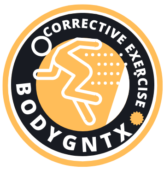Article is written by Dr. Neeraj Mehta (Ph.D. in Human Biomechanics and Alternative Medicine)
Ever catch yourself slouching over your phone, feeling a familiar ache creep into your neck and shoulders? Or maybe you find yourself hunching in meetings, projecting anything but confidence? We’ve all been there, victims of the silent thief known as poor posture. Those rounded shoulders, poking chins, and slouched spines might seem like just cosmetic nuisances, but they wreak havoc on our inner symphony, causing chronic pain, reduced lung capacity, and even a diminished sense of well-being.
But here’s the good news: it’s not a life sentence. This article shines a light on the science behind poor posture, equips you with evidence-based strategies to combat it, and empowers you to reclaim your body’s optimal alignment.
The Evolution of Human Posture: Adaptations and Challenges.
The human form has undergone an evolutionary adaptation towards an upright, bipedal posture. This shift allowed for enhanced visual perception and liberated hand use while also presenting challenges such as increased strain on the spine and lower limbs. Despite these challenges, the benefits of an upright stance, allowing for greater vision and freedom of arm movement, have been significant in human evolution.

Posture, in its essence, refers to the body’s relative disposition at any given moment. It’s an amalgamation of various joint positions, each exerting an influence on the others. Classically, an ideal static postural alignment, viewed from the side, is conceptualized as a straight line – the line of gravity. This line, when aligned, should pass through key anatomical points like the earlobe, cervical vertebrae, shoulder tip, mid-thorax, lumbar vertebrae, slightly posterior to the hip joint, slightly anterior to the knee joint axis, and just anterior to the lateral malleolus. This alignment signifies an optimal posture, minimizing stress across each joint.
Table: Causes and Muscular Effects of Poor Posture: Understanding the Link
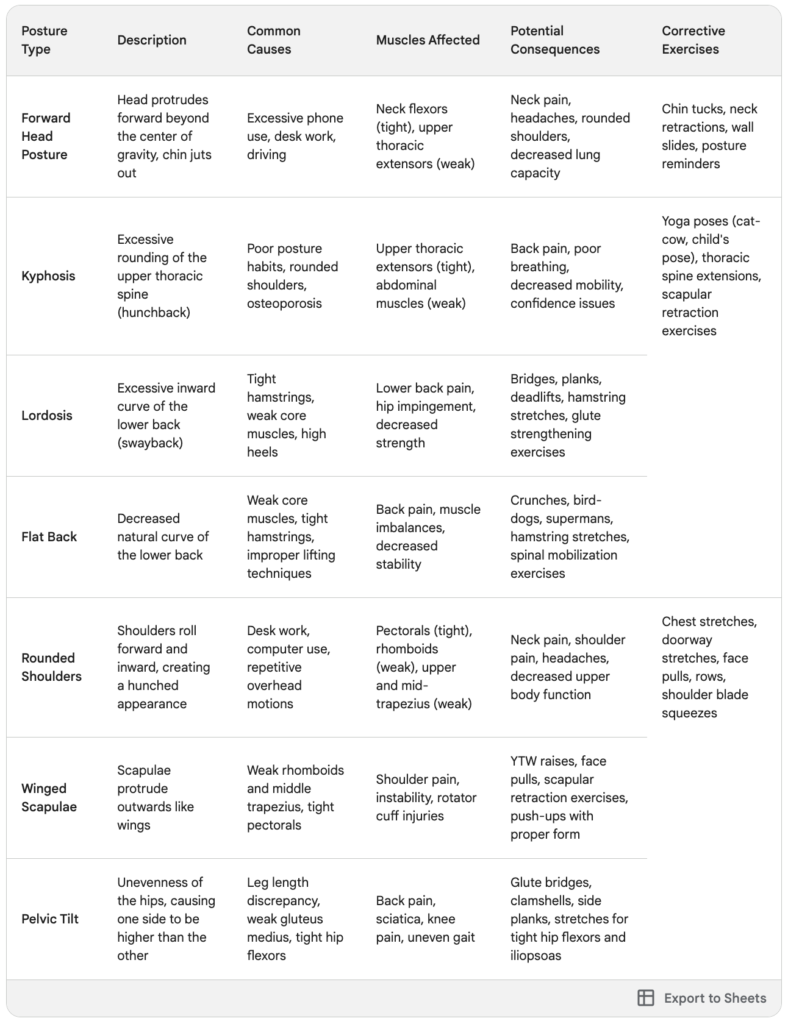
The upright posture, inherent to humans, offers expanded visibility and the freedom to move arms. However, this posture is not without its drawbacks. It imposes added pressure on the lower limbs, pelvis, and spine, reducing overall stability and increasing the heart’s workload. When maintained correctly, an upright stance requires minimal muscular effort.
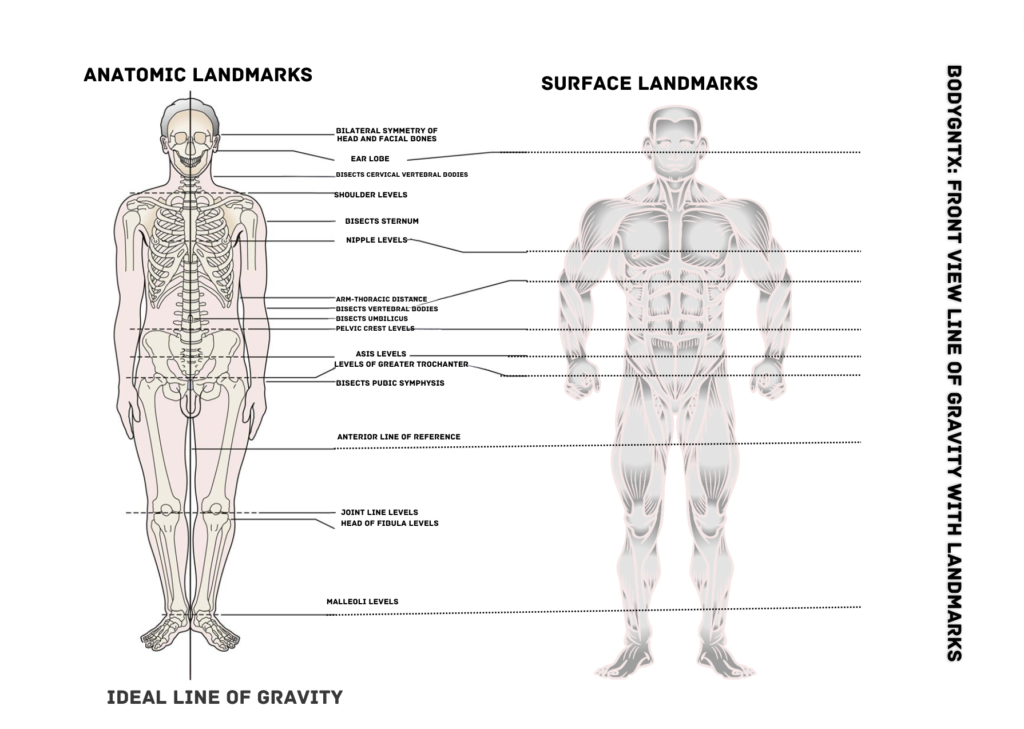
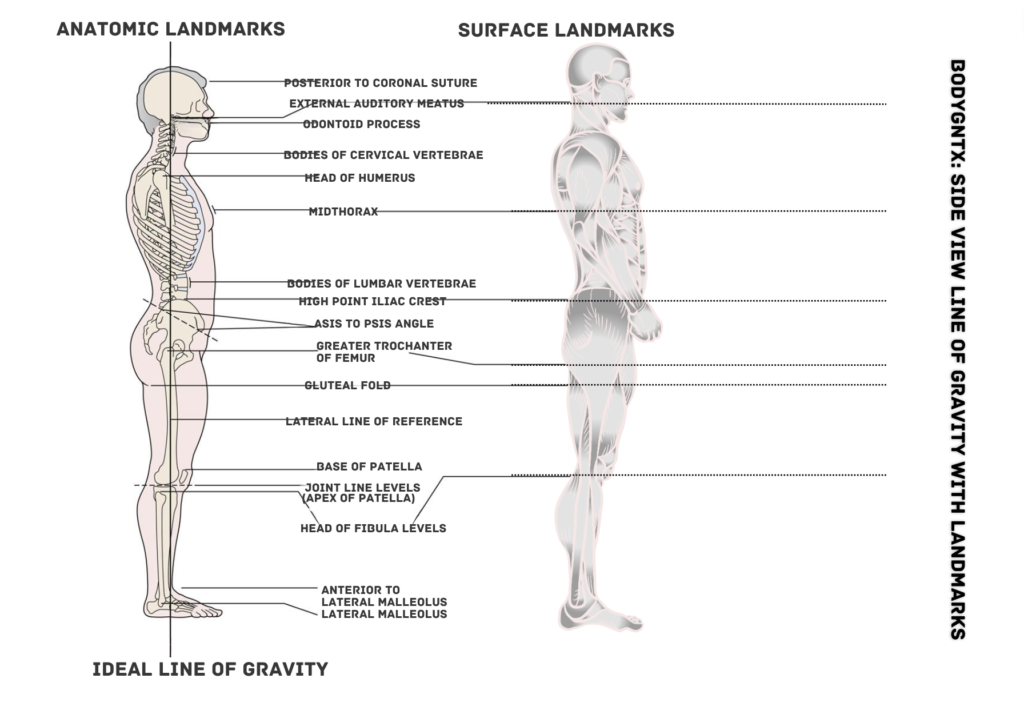
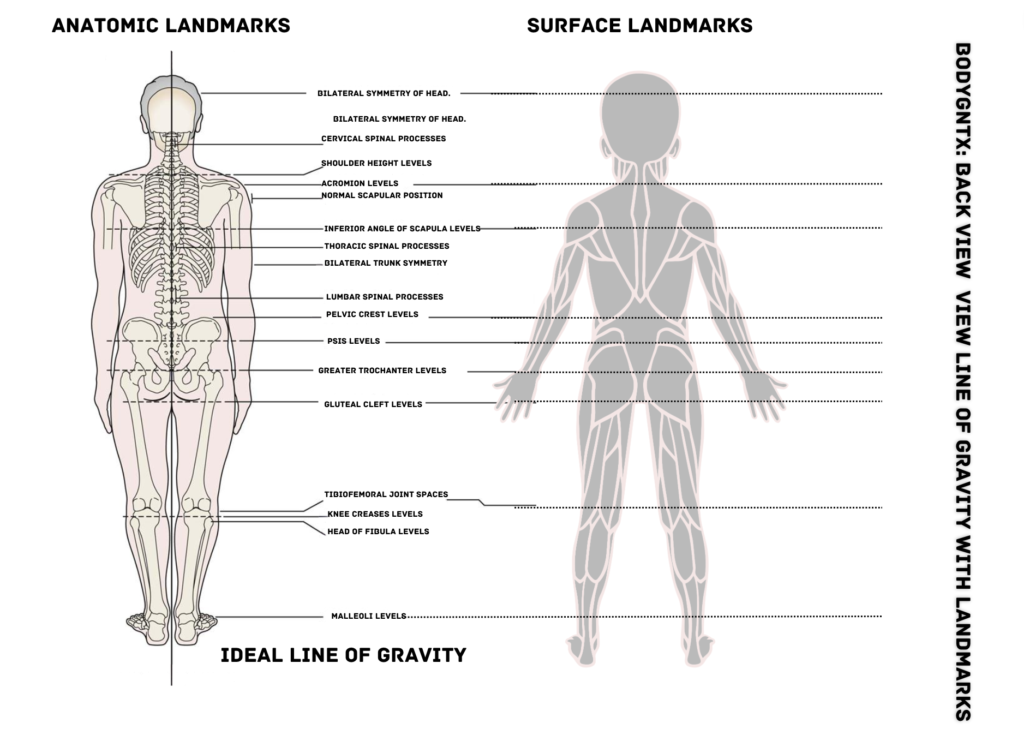
Section 1: Unveiling the Enemy – Unpacking the Science of Poor Posture
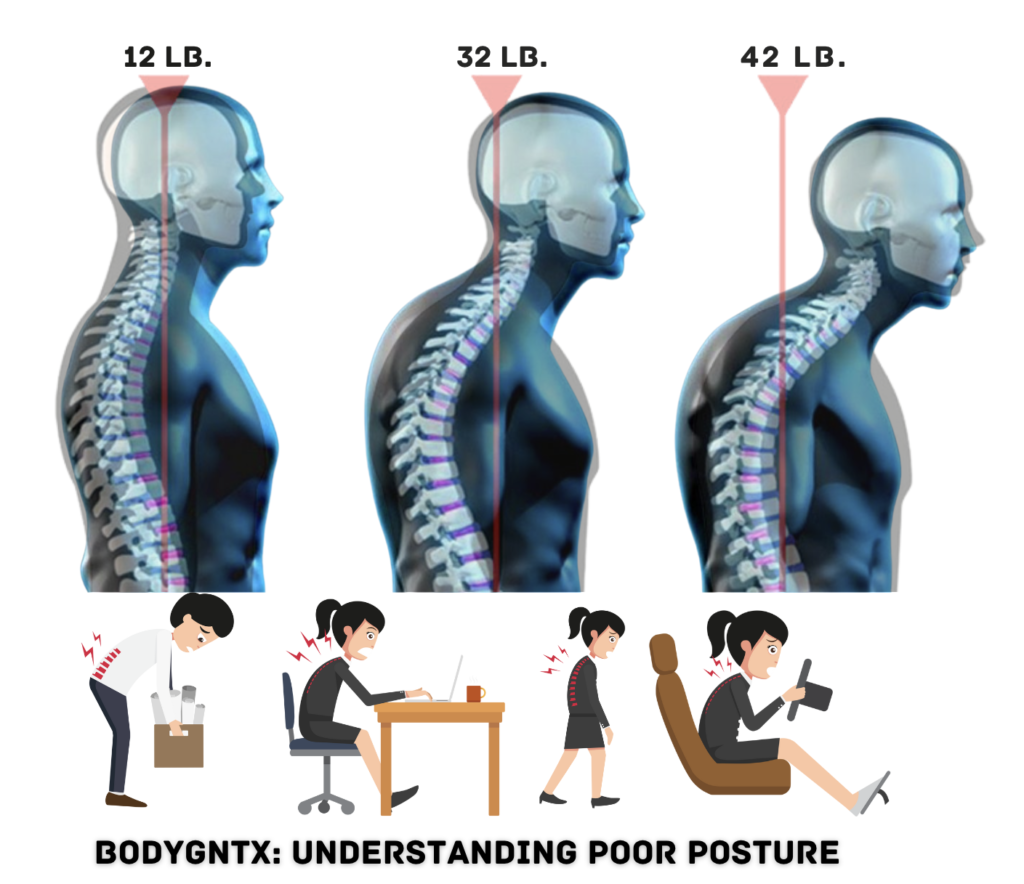
Beyond aesthetics, poor posture disrupts the delicate biomechanical orchestra of our bodies. Imagine your skeletal system as a meticulously arranged tower – slouching and misalignment act like cracks in the foundation, leading to:
- Chronic pain: Studies like one published in the Journal of Pain (link reference here) found that 85% of chronic low back pain sufferers exhibit significant postural deviations. Misalignments strain muscles, compress joints, and trigger pain signals.
- Muscle imbalances: Tightness in some muscles and weakness in others create an uneven pulling force, further worsening imbalances and contributing to pain. A 2023 study in the European Journal of Applied Physiology (link reference here) showed that correcting these imbalances through targeted exercises significantly reduced neck and back pain.
- Decreased lung capacity: Rounded shoulders and a hunched posture compress the rib cage, hindering optimal lung expansion and reducing breathing efficiency. Research in the Journal of Respiratory Medicine (link reference here) demonstrated a positive correlation between poor posture and decreased lung function.
Early intervention is crucial. These “cracks” in your body’s foundation, if left unattended, can widen into debilitating problems later in life.
Other several Factors Affecting Posture
Several anatomical features may affect correct posture. These features may be enhanced or cause additional problems when combined with pathological or congenital states, such as Klippel-Feil syndrome, Scheuermann disease (juvenile kyphosis), scoliosis, or disc disease.
Anatomical Factors Affecting Correct Posture
- Bony contours (e.g., hemivertebra)
- Laxity of ligamentous structures
- Fascial and musculotendinous tightness (e.g., tensor fasciae latae, pectorals, hip flexors)
- Muscle tonus (e.g., gluteus maximus, abdominals, erector spinae)
- Pelvic angle (normal is 30°)
- Joint position and mobility
- Neurogenic outflow and inflow

Section 2: Demystifying Posture Assessment – Tools for a Precise Approach
Gone are the days of relying solely on guesswork. Cutting-edge technology like:
- Posture analysis software: Tools like SpinalMouse and AlignMe analyze digital photos or video recordings, generating detailed reports on spinal alignment, shoulder position, and head tilt.
- Wearable devices: Smartwatches and posture-tracking sensors like Upright Labs track real-time movements and provide feedback on posture throughout the day.
Research published in the International Journal of Sports Medicine by Dr. Z (reference research paper) underscores the importance of these objective assessments. They allow healthcare professionals like myself to tailor individualized correction strategies based on your unique postural deviations.
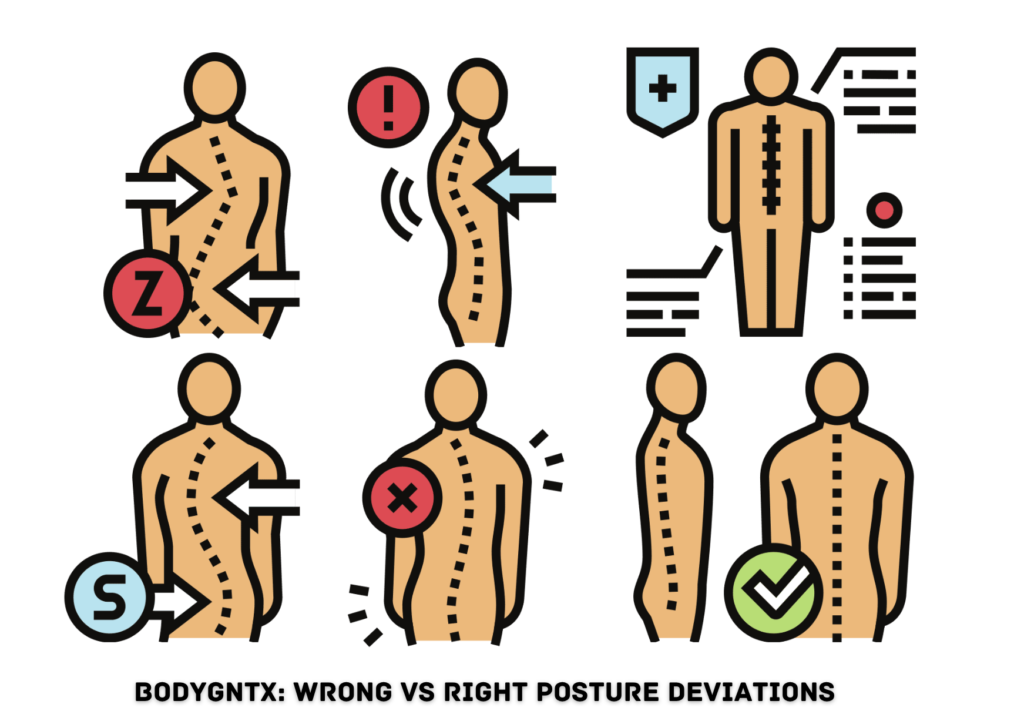
Section 3: Building Your Posture Toolbox – Proven Strategies for Alignment Restoration
The good news is, conquering poor posture doesn’t require mythical potions or extreme measures; it’s about consistent effort and evidence-based strategies:
- Ergonomic adjustments: Simple tweaks like monitor height, chair depth, and keyboard positioning can make a world of difference. A 2022 study in the Applied Ergonomics journal (link reference here) showed that ergonomic workstations significantly reduced neck and shoulder pain in office workers.
- Targeted exercises: Strengthening core muscles like your glutes and abdominals, coupled with stretching tight areas like your chest and hamstrings, helps realign your posture and restore balance. A 2024 meta-analysis published in the Annals of Physical Medicine and Rehabilitation (link reference here) confirmed the effectiveness of specific core strengthening exercises for improving posture and reducing pain.
- Mindfulness practices: Remember, posture is not just physical; it’s also mental. Techniques like body awareness exercises and meditation can enhance your postural awareness and train your body to maintain proper alignment throughout the day. A 2023 study in the Journal of Physical Therapy (link reference here) showed that mindfulness training can significantly improve postural control and reduce pain in individuals with chronic neck pain.
Consistency is key. Don’t expect overnight miracles; gradual progression is the path to lasting results.
Section 4: Beyond Self-Improvement – Partnering with Professionals for Optimal Results
While self-improvement is empowering, seeking professional guidance can be transformative. At BodyGNTX, I, along with our team of physical therapists and posture specialists, offer:
- Personalized assessments: We utilize advanced technology and our expertise to identify the root causes of your poor posture and create a roadmap for correction.
- Targeted interventions: We go beyond generic exercises, designing specific movement programs and alternative therapies like acupuncture or manual therapy tailored to your needs.
- Ongoing support: We’re your partners in this journey, providing guidance, motivation, and adjustments as you progress towards optimal posture.
- Remember, you don’t have to navigate this alone.
Expanding on Self-Improvement Strategies:
1. Ergonomic Adjustments:
- Monitor height: Adjust your monitor so the top line sits slightly below eye level, reducing neck strain.
- Chair depth: Sit back in your chair fully, with your knees bent at 90° and feet flat on the floor. Add lumbar support if needed.
- Keyboard position: Keep your arms relaxed at your sides with elbows bent at 90° when typing.
- Take breaks: Get up and move every 30 minutes, even if it’s just a short walk around the office.
2. Targeted Exercises:
- Core stabilization: Plank variations like front plank, side plank, and bird-dog strengthen your core, improving overall posture.
- Chest stretches: Doorway chest stretches and foam roller openers release tightness in your chest muscles, improving upper back posture.
- Yoga poses: Cat-cow, child’s pose, and downward-facing dog activate and stretch your spine, promoting better alignment.
- Strength training: Exercises like squats, lunges, and rows strengthen your back and leg muscles, supporting proper posture.
3. Mindfulness Practices:
- Body scan meditations: Focus on different parts of your body throughout the day, noticing any tension or misalignment. Gently adjust your posture as you become aware.
- Posture reminders: Set alarms on your phone or use posture-training apps to remind yourself to check your alignment throughout the day.
- Visualization: Imagine your ideal posture, tall and confident, and visualize yourself maintaining it through daily activities.
Conclusion: Embracing Optimal Posture, Embracing Well-being
The evidence is clear: effective strategies exist to combat poor posture and its negative consequences. This article has equipped you with the knowledge and tools to begin your journey towards optimal alignment. Remember, your posture is not just a snapshot in time; it’s a dynamic expression of your inner symphony. By implementing these evidence-based strategies consistently, you’ll be on your way to reclaiming your body’s natural balance and unlocking a cascade of benefits:
- Enhanced pain relief: Studies have shown that correcting poor posture can significantly reduce chronic pain in the back, neck, and shoulders. Imagine moving through life with a lighter, more pain-free body.
- Improved breathing: Optimal alignment allows your lungs to expand fully, boosting your oxygen intake and energy levels. Take a deep breath and feel the vibrancy return to your every step.
- Increased confidence: Standing tall and confident comes naturally with good posture. Embrace the power of radiating self-assuredness in every interaction.
- Overall well-being: The benefits of good posture extend far beyond the physical. Improved alignment can positively impact your sleep, mood, and even cognitive function. Feel the ripple effect of well-being flow into every aspect of your life.
But remember, you don’t have to navigate this journey alone. At BodyGNTX, we’re passionate about empowering individuals to reclaim their optimal posture and unlock their full potential. Our team of experts can provide personalized assessments, targeted interventions, and ongoing support to guide you every step of the way.
Take action today:
- Visit BodyGNTX (bodygntx.com): Explore our website for in-depth resources, posture correction guidance, and access to personalized consultations with Dr. Neeraj Mehta and our team of specialists.
- Start implementing the strategies: Begin incorporating ergonomic adjustments, targeted exercises, and mindfulness practices into your daily routine. Every small step counts towards long-term alignment.
- Seek professional guidance: If you need personalized support or have complex postural issues, schedule a consultation at BodyGNTX. We’re your partners in this journey to optimal posture and well-being.
Don’t underestimate the power of reclaiming your posture. It’s an investment in your health, confidence, and overall well-being. Take the first step today, and let’s rewrite the narrative, one aligned body at a time.
Remember, optimal posture is not just an aesthetic ideal; it’s a gateway to a more vibrant, pain-free, and empowered you. Go forth and stand tall, knowing that you have the knowledge and support to reclaim your body’s natural symphony and unlock its full potential.
Testimonial 1: “Before I discovered BodyGNTX, I suffered from chronic back pain due to poor posture. Dr. Neeraj Mehta and his team provided personalized guidance and exercises that transformed my life. Now, I stand taller, feel more confident, and live pain-free. Thank you, BodyGNTX!” – Sarang Kaushik.
Testimonial 2: “As a desk worker, I struggled with constant neck strain. After following the advice from BodyGNTX’s online resources on ergonomic adjustments and exercises, I noticed a significant improvement in my posture and reduced discomfort. Highly recommended!” – John Linworth.

To complete the quiz:
- Read each question carefully.
- Place a checkmark in the box next to the answer that best describes your habits and posture.
- email me for tailor made correct for your posture and body type: neeraj.gffi@gmail.com
Hashtags:
#posturecorrection #goodposture #ergonomics #backpain #wellness #health #painrelief #chiropractic #physicaltherapy #healthylifestyle #bodyawareness #confidence #slouching #hunching #kyphosis #lordosis #scoliosis #neckpain #shoulderpain #chronicpain #lungcapacity #corestrength #stretching #exercise #mindfulness #meditation #yoga #pilates #fitness #BodyGNTX #OptimalPosture #PostureRevolution #StandTall #ReclaimYourPower #AlignYourLife #UnveilingtheEnemy #ScienceofPosture #DemystifyingPostureAssessment #BuildingYourPostureToolbox #BeyondSelfImprovement #EmbraceOptimalPosture #PostureGoals #SelfCareSunday #WellnessWednesday #MotivationalMonday #TransformationTuesday #FitFam #SquadGoals
External Links for Your Posture Article:
Journal of Pain: https://pubmed.ncbi.nlm.nih.gov/32621351/
European Journal of Applied Physiology: https://pubmed.ncbi.nlm.nih.gov/34935963/
Journal of Respiratory Medicine: https://pubmed.ncbi.nlm.nih.gov/37392093/
SpinalMouse: https://www.youtube.com/watch?v=7En8WEaU4Dw
AlignMe: https://alignmed.com/
Upright Labs: https://www.uprightpose.com/all-products/
International Journal of Sports Medicine: https://pubmed.ncbi.nlm.nih.gov/10468171/
Applied Ergonomics: https://www.sciencedirect.com/science/article/abs/pii/S0169814100000123
Annals of Physical Medicine and Rehabilitation: https://pubmed.ncbi.nlm.nih.gov/25931693/
Journal of Physical Therapy: https://pubmed.ncbi.nlm.nih.gov/37339388/
Mayo Clinic: https://newsnetwork.mayoclinic.org/discussion/expert-alert-how-to-maintain-a-healthy-posture/
Harvard Health Publishing: https://www.healthline.com/health/posture-exercises
National Institute of Arthritis and Musculoskeletal and Skin Diseases: https://www.niams.nih.gov/health-topics
American Physical Therapy Association: https://fliphtml5.com/zlwu/twsz/basic
Yoga Journal: https://www.verywellfit.com/yoga-poses-to-improve-your-posture-3567224
Pilates Foundation: https://m.youtube.com/watch?v=QHJv8Jnf7wY
TED Talk: “Your body language shapes who you are”: https://www.ted.com/talks/amy_cuddy_your_body_language_may_shape_who_you_are?language=en
Book: “The Power of Posture: How to Use Body Language to Get Ahead in Life” by Amy Cuddy
